Platzl (Munich)
| Space | |
|---|---|
| Place in Munich | |
 Platzl with a view of the Hofbräuhaus |
|
| Basic data | |
| place | Munich |
| District | Old town |
| Created | 14th century |
| Confluent streets | Pfisterstraße, Am Kosttor, Bräuhausstraße, Orlandostraße, Münzstraße |
| Buildings | Hofbräuhaus |
| use | |
| User groups | Foot traffic |
In Munich, the Platzl is both the square-like, extended street northeast of Marienplatz and the restaurant and theater of the same name that was formerly located there.
Street and Neighborhood
The old Munich street name Platzl has existed at this point since at least 1780. It describes the square-like extension of the northern Orlandostraße that ends there. In the period from 1368 to 1805, this place was also referred to as Graggenau in the Munich tax and court books . The most famous building on the Platzl is the Hofbräuhaus . In the immediate vicinity there are other localities such as Alfons Schuhbeck's South Tyrolean Stuben , the Platzl Hotel and a Hard Rock Cafe .
Theater am Platzl
From 1901 until its closure in 1995, the Theater am Platzl primarily provided a stage for folk singers. Directors in its 98-year history were well-known originals such as Weiß Ferdl , Michl Lang and then Ludwig Schmid-Wildy . From September 1995 to June 1997, Platzl's Theaterie was located there as one of the first dinner & show theaters in Germany.
Building group Platzl 2–3
The houses Platzl 2 and 3 are rare examples of old Munich town houses. Some remains from the Middle Ages are still preserved (front building Platzl 3). The main construction phases are the Renaissance (front building, Platzl 2, around 1565) and the Baroque (Platzl 2, central building, mid-17th century, rear building, first half of the 18th century; central building, Platz 3, heightening of the front building, Platzl 3, around 1700). In 1987/88 the group of houses was redeveloped (architects Wolfgang Brückner and Georg Gussmann) and a detailed construction study was carried out with significant losses of historical substance. Today passages open up the inner courtyards.
Orlando house
The ornate five-story Orlando home was completed in 1900 and is located north of the square. There is an arcade on the ground floor.
Student associations
Striking connections have been at home on Platzl since the 19th century . The Corps Bavaria , Corps Makaria Munich , Corps Franconia , Corps Rheno-Palatia Munich , Corps Hercynia , Corps Vitruvia , Corps Cisaria as well as the fraternity Rhenania are at home at Platzl. Today, of the connections listed, the Kösener Corps Rheno-Palatia Munich and the two Weinheimer Corps Vitruvia and Cisaria are still represented at the Platzl. All of the named corps exist to this day and are members of the Munich Seniors' Convent (MSC), with Franconia and Bavaria moving to Bogenhausen and Makaria owning a house in Schwabing , Hercynia merged with the Corps Arminia Munich in 2015. The Rhenania fraternity merged with the Arminia fraternity to form the Arminia-Rhenania fraternity in Munich and is now based in Bogenhausen.
literature
- Cornelia Oelwein: Das Münchner Platzl - Joy of Life in the Square , Munich 2003, ISBN 3-928432-34-6
- Heinrich Habel, Johannes Hallinger, Timm Weski: Monuments in Bavaria - State capital Munich. Center. 3 Vol. Munich 2009, Vol. 2, pp. 780–788.
Web link
Individual evidence
- ^ The royal Hofbräuhaus and the old Hofbräuhauskeller , year book for Munich history, vol. 4 p. 448, Munich, 1890.
- ^ Heinrich Habel, Johannes Hallinger, Timm Weski: Monuments in Bavaria - State capital Munich. Center. 3 Vol. Munich 2009, Vol. 2, pp. 781–783.
Coordinates: 48 ° 8 ′ 17 ″ N , 11 ° 34 ′ 48 ″ E